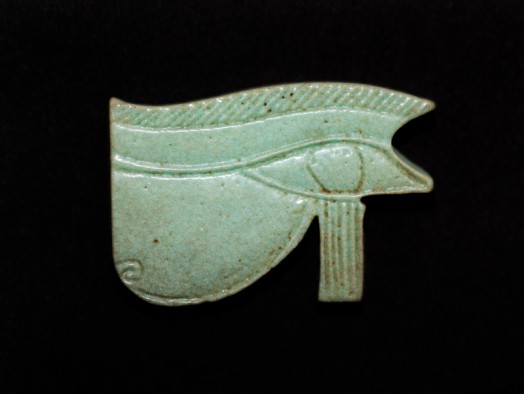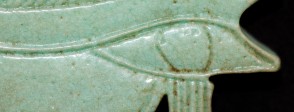
A symbol of protection
This amulet represents the eye of Horus, the Egyptian god of kingship. Horus was often represented as a falcon, so the amulet is shown with a falcon’s eye markings. It is made of faience, a kind of ceramic material very popular in ancient Egypt. The blue-green colour symbolized growth and healing. Faience, also called Egyptian paste, is cheap to make and easy to shape in moulds, and lucky charms like this were produced in their thousands. Even a poor person could afford to own one, so they can tell us a lot about the religious beliefs of ordinary people.
The Egyptian world
Everything the Egyptians believed was shaped by Egypt’s natural environment. All around them, they saw gods and goddesses in the sun and the river, in birds, animals and insects, in plants and trees, in the earth and sky. The clever baboon became Thoth, the god of learning and medicine, the jackal who prowled the cemeteries became Anubis, the god of mummification, the motherly cow became Hathor, the goddess of love and fertility.
The early Egyptians thought their world had been created by a sun god who came out of the water. First he made Shu, the god of air and Tefnut, the goddess of moisture. They gave birth to Geb, the earth god and Nut, the sky goddess. Geb and Nut had four children: the gods Osiris and Seth, and the goddesses Isis and Nephthys.
Osiris and Seth were put in charge of Egypt, but while Osiris’ half of the country flourished, Seth’s turned to desert. Seth was jealous. He murdered Osiris and took his throne, but Osiris’ wife, his sister Isis, kept their son Horus safe until he was old enough to avenge his father. Finally, after a long series of battles, Horus defeated Seth and became king of Egypt. During one of these battles, Horus’ eye was torn out by Seth, who ripped it to pieces in his anger. It was restored by Thoth, after which it was called wedjat, ‘The Whole One’ and became a symbol of healing. In time, the Eye of Horus became one of the most popular amulets, worn by the Egyptians for protection and good health.
Cycles of life and death
Osiris could not return to life on earth, but he did live again as the ruler of the Underworld, the land of the dead. The Egyptians thought that the entrance to the Underworld was in the western horizon, where the sun set each evening, so cemeteries were usually to the west of towns.
The sun god, they believed, was born every morning in the eastern horizon as the scarab Khepri, god of the rising sun, who grew older as he crossed the sky through the day. At noon, he was called Ra, and in the afternoon, Atum. In the evening he died and entered the Underworld. After travelling through the Underworld during the night hours he was born again the next morning.
All of life in Egypt depended on the balance of nature, and especially on the Nile flood. If there was too little water, the crops could not grow, but if there was too much, the fields and houses would be washed away. Either way, the people would starve.
Temples
The Egyptians believed that their deities could make sure that everything stayed in balance. This divine order was personified as the goddess Maat. The government made images of the gods and goddesses and built temples for them to live in. Priests and priestesses were appointed to act as their servants. They prayed to the gods and goddesses on behalf of the community, and made offerings to the divine images to guarantee their favour.
Only the priests and priestesses were allowed into the sacred temple building, so the only time ordinary people saw their gods and goddesses was during religious festivals, when their statues were carried out in processions. They could, however, pray and make offerings to ‘hearing ear’ images of the deities outside the temple walls. They could also buy protective spells and amulets like this one, which were produced in the temple workshops.
More information
More information on the wedjat eye
http://www.britishmuseum.org/explore/highlights/highlight_objects/aes/f/faience_wedjat_eye_amulet.aspx
Isis and Osiris
http://www.britishmuseum.org/explore/highlights/highlight_objects/aes/s/statue_of_isis_protecting_osir.aspx
Isis and Horus
http://www.britishmuseum.org/explore/highlights/highlight_objects/aes/b/bronze_figure_of_isis__horus.aspx
Stela of a workman worshipping Seth
http://www.britishmuseum.org/explore/highlights/highlight_objects/aes/l/limestone_stela_of_aapehty.aspx
Calendar of lucky and unlucky days
http://www.britishmuseum.org/explore/highlights/highlight_objects/aes/p/papyrus_with_a_calendar_of_luc.aspx
Egyptian religion
Summary of Egyptian religion, with links to resources on priests, including a description of a day in the life of a priest.
http://www.pbs.org/empires/egypt/newkingdom/religion.html
Brief overview of ancient Egyptian temples
http://www.britishmuseum.org/explore/highlights/articles/a/ancient_egyptian_temples.aspx
Information on Egyptian priests
http://www.touregypt.net/featurestories/priests.htm
Popular religion
Useful article on all aspects of popular religion, including local shrines, household deities, oracles and magic.
http://www.bbc.co.uk/history/ancient/egyptians/magic_01.shtml
Egyptian amulets
Useful introduction to Egyptian amulets, with illustrations.
http://www.metmuseum.org/toah/hd/egam/hd_egam.htm
Article on animals in Egyptian religion
http://www.prm.ox.ac.uk/AnimalMummification.html
Animal mummies
Brief overview of Egyptian animal mummies in the British Museum.
http://www.britishmuseum.org/explore/highlights/articles/e/egyptian_animal_mummies.aspx
The god Bes
Detailed article on the god Bes and his role as a household deity
http://ancientegyptonline.co.uk/bes.html
More information
-
More information on the wedjat eye
Source: britishmuseum.org
-
Isis and Osiris
Source: britishmuseum.org
-
Isis and Horus
Source: britishmuseum.org
-
Stela of a workman worshipping Seth
Source: britishmuseum.org
-
Calendar of lucky and unlucky days
Source: britishmuseum.org
-
Egyptian religion
Summary of Egyptian religion, with links to resources on priests, including a description of a day in the life of a priest.
Source: pbs.org
-
Brief overview of ancient Egyptian temples
Source: britishmuseum.org
-
Information on Egyptian priests
Source: touregypt.net
-
Popular religion
Useful article on all aspects of popular religion, including local shrines, household deities, oracles and magic.
Source: bbc.co.uk
-
Egyptian amulets
Useful introduction to Egyptian amulets, with illustrations.
Source: metmuseum.org
-
Article on animals in Egyptian religion
Source: prm.ox.ac.uk
-
Animal mummies
Brief overview of Egyptian animal mummies in the British Museum.
Source: britishmuseum.org
-
The god Bes
Detailed article on the god Bes and his role as a household deity
Source: ancientegyptonline.co.uk


